Allen Park — What more can be said or written about James Houston’s performance this season? The Detroit Lions rookie edge rusher has been a revelation since his promotion from the practice squad in late November.
What Houston has been able to accomplish, eight sacks in six games, is historic. Since sacks became an official stat in 1982, 67 players have recorded eight sacks in their first season, but none have tallied that many in their first six games.
For this week’s film review, it felt worthwhile to look beyond the scope of the Detroit Lions’ 41-10 victory over the Chicago Bears. Instead, we’re going to take a longer view of Houston’s rapid development, from playing just five snaps in his professional debut to having the training wheels fully removed in his three-sack effort against the Bears.
▶ vs. Buffalo Bills, Nov. 24, five snaps
Houston’s bump up from the practice squad came on the heels of Charles Harris aggravating a nagging groin injury. The plan was never more than to give the rookie a taste, given the team had more trusted depth options on the roster.
In the matchup, Austin Bryant and Julian Okwara combined for 60 snaps, so Houston didn’t see the field until the closing seconds of the second quarter, with the Bills already in field-goal range at Detroit’s 20-yard line. It was here the legend was born.
More: Four Downs: James Houston hype, Lions’ clock management and Ford Field’s atmosphere
Standing up as a wide rusher across the right side of the Bills’ formation, Houston navigated around the running back going out on a route to the flat prior to showcasing his flexibility, chopping through the right-handed stab of right tackle Spencer Brown before bending around the outside of the blocker.
Houston got so low, his right hand scraped the ground as he cornered. Coming out of the bend, he took two more strides, before reaching and dropping Buffalo quarterback Josh Allen.
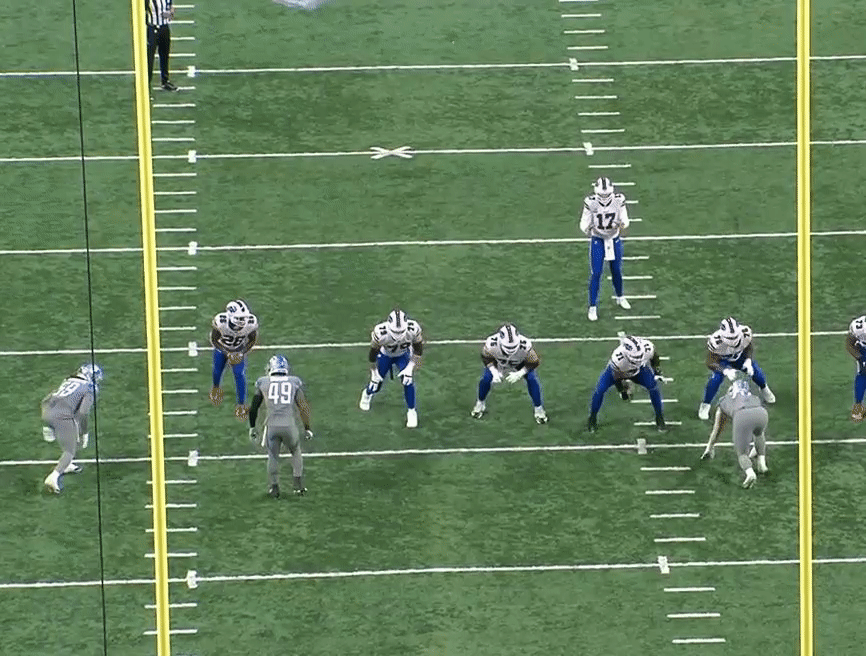
Houston’s second snap was wiped off the books by a pass interference penalty, so when he got to Allen again the next rep, we can technically say the rookie recorded a sack each of his first two plays.
Again checking in on third down, which you’ll see will be a theme the next month for Houston, he lined up on the opposite side from his previous sack. On the snap, he initially had to power through a chip from running back Taiwan Jones before engaging left tackle David Quessenberry. Maybe engaging is a bad choice of words since shot right around the block.
Flushed from the pocket, Allen was in the process of rolling to his right, but despite tripping and stumbling to the ground, Houston was able to bring the quarterback down from behind.

Houston didn’t do anything of consequence his final snaps against the Bills, two more third-and-long situations. But one amusing observation, related to his relative inexperience, is he had to be physically corrected on his alignment by middle linebacker Alex Anzalone multiple times.
That’s worth noting as a reminder how unprepared Houston was for a bigger role at the time of his debut.

▶ vs. Jacksonville Jaguars, Dec. 4, 12 snaps
Following the impact in his first appearance, and an injury to Okwara, the Lions were able to more than double Houston’s workload in his second game. Still the role remained defined to clear passing situations. Eleven of his 12 reps came on third downs of 6 or more yards or during the Jaguars’ two-minute drill to end the first half. The other came on a second-and-15 play.
Entering the game late in the first quarter, Houston had an immediate impact, dipping his shoulder and bending around left tackle Cam Robinson to get a hit on Jaguars quarterback Trevor Lawrence. Impressively, the QB was still able to complete a pass for a first down.

Robinson either got the best of Houston or the Jaguars got the ball out too quickly the next several rush reps, but we did see a slow expansion of the versatility during this stretch, including some bull rushes and the defender’s first stunt, looping inside, around the defensive tackle.
With 20 seconds remaining in the first half, and Jacksonville threatening to enter field goal range, Houston got home for his third sack of the season. It’s probably the most memorable of his quarterback takedowns.
Rushing from his usual wide alignment, Houston skipped as he approached the left tackle, before hitting the gas as his feet hit the ground, easily bending the corner and hitting Lawrence hard, twisting the quarterback to the ground to squash the scoring threat.
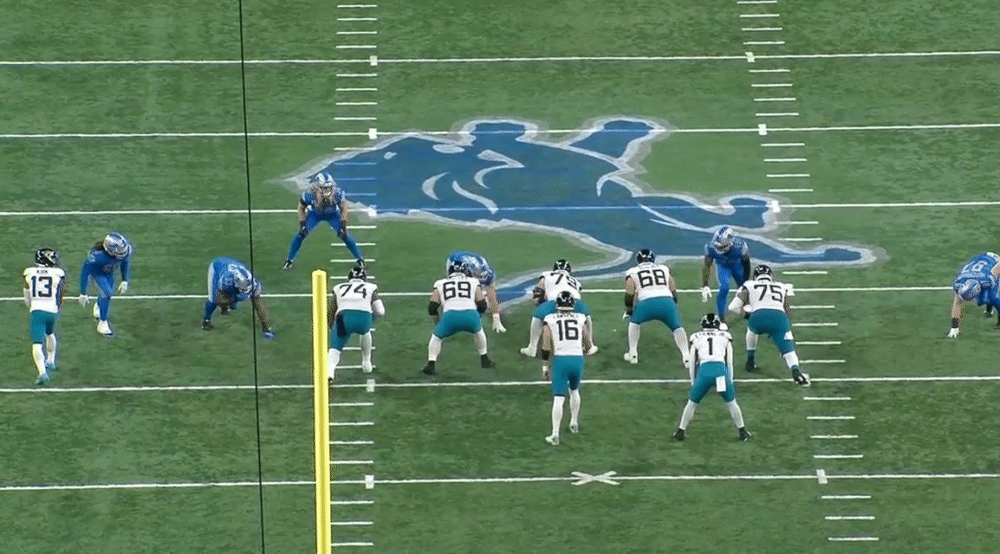
Robinson won all four second-half reps, including a couple more tries with the skip move, but it proved to be another productive day for Houston with the sack and quarterback hit in limited work. His bend continued to be his primary asset, but hints of power started to show up in this second game.
▶ vs. Minnesota Vikings, Dec. 11, 21 snaps
This game marked the return of Romeo Okwara, but Houston’s productivity the previous two weeks not only kept him in the lineup, it allowed him to jump Austin Bryant on the depth chart. The latter ended up a healthy scratch for the contest.
Meanwhile, Houston’s workload increased another 75%. Still, within that, the Lions continued to show a reluctance to use him outside of packages he’d already been playing: third downs and two-minute drill.
Working off the right edge, Houston didn’t have the first-snap impact he did in the previous two games, losing his footing on his first rep and getting stymied by left tackle Blake Brandel the next two. But on a third-and-nine midway through the second quarter, Houston found a lane into the backfield while running a stunt, flushing quarterback Kirk Cousins from the pocket.
Cousins managed to get off a back-foot throw under duress, but the completion to Justin Jefferson was short of the line to gain, leading to a punt. That’s impact that doesn’t show up in a box score.

Houston managed to extend his sack streak to three games on the final play of the quarter, once again using his burst and bend to beat the tackle before taking out Cousins’ legs.
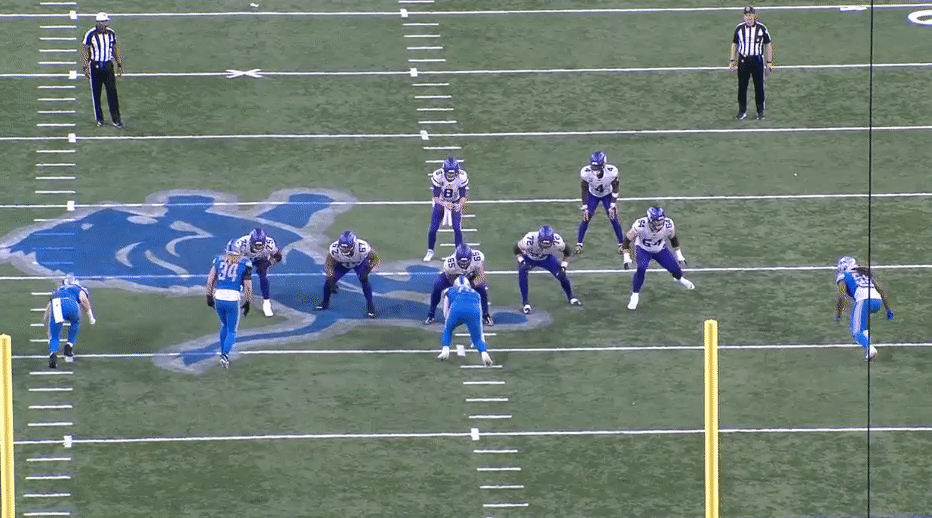
In the second half, we got to see the first instance of Houston dropping into coverage. It’s certainly not a foreign concept, having played off the ball at Florida before transitioning to edge rusher following his transfer to Jackson State.
On the third-and-four snap, Houston jammed former teammate T.J. Hockenson at the line of scrimmage as part of a double-team on the Vikings’ popular third-down target before dropping into a shallow zone in the middle of the field. That act forced Cousins to look elsewhere, leading to an incompletion.
In the fourth quarter, as the Lions expanded the lead to two scores, the door opened for Houston to see more reps. His nine snaps in the final frame were nearly double what he played against Buffalo, and he kickstarted the quarter with pressure via his patented skip step rush, leading to a throwaway on third down.
Mixing and matching rush moves, including a previously unused spin, Houston didn’t find any late-game success working against backup left Olisaemeka Udoh, in part because the Vikings were getting the ball out quickly while attempting to orchestrate a comeback.
Still, regardless of the muted finish, Houston had another impactful outing with the sack and two third-down pressures that stalled out drives.
▶ at New York Jets, Dec. 18, 25 snaps
Houston’s playing time continued to expand in his fourth game, and the role expanded slightly, as well. Against the Jets, he was given the opportunity to stay on the field in some third-and-short situations.
It was on one of those plays, he earned his fifth sack. With third-and-2 near midfield, the Jets left Houston unblocked to the left side of the formation, trying to freeze the rookie with eye candy, starting with a pre-snap motioning of a receiver to that side. But the key read was slot receiver Braxton Berrios, who pulled beyond the formation and feigned blocking Houston before dodging the defender and going into a route.
The combination of Houston not hesitating through the distractions and safety Kerby Joseph picking up Berrios in coverage, led to one of the easiest sacks any Lions player has seen this season.

Through the second and third quarters, Houston had no impact, despite playing 13 snaps. That was due to a combination of the Jets getting the ball out quickly and the rookie running into a quality, veteran offensive tackle in Duane Brown. He’s started 215 games in the NFL and has seen every type of rusher and rush move the league has to offer.
Houston finally managed to dip under and around Brown early in the fourth quarter, even getting a hand on quarterback Zach Wilson, but not before the pass was released.
The rookie edge rusher didn’t return to action until late in the quarter, when the Jets were attempting to orchestrate a two-minute drive to tie or win the game. On the second snap of the series, Houston impressively defeated a double team, powering through running back Michael Carter before dipping around Brown’s outside shoulder, hitting Wilson a fraction of a second after he released a pass that would fall incomplete.
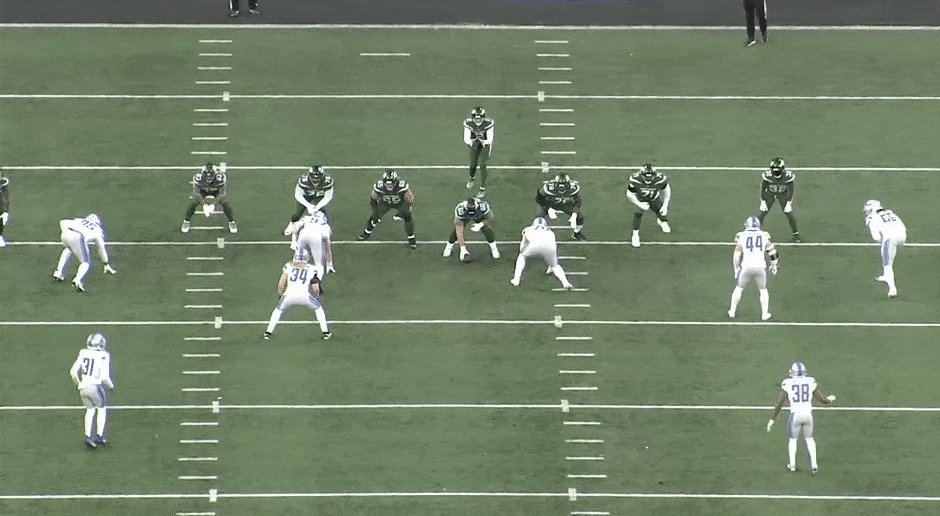
Three plays later, Houston got the edge on Brown again, registering another hit on Wilson, although the QB still managed to complete a 10-yard throw to keep the drive alive.
Houston’s final impact was getting edge pressure that forced Wilson to step up in the pocket, where he was dropped for a sack by John Cominsky.
In terms of efficiency, this wasn’t Houston’s best performance, but with an early sack, followed by three pressures during the two-minute drive at the end the game, that’s still high-level impact, regardless of experience level.
▶ at Carolina Panthers, Dec. 24, 14 snaps
Schematically, the Panthers’ run-heavy style, which creates a lot of short-yardage situations on third down when it’s operating effectively, wasn’t going to be a good formula for utilizing Houston. That played out as he saw just 14 snaps, his fewest in three weeks.
Houston played only one snap in the opening quarter, but maximized the opportunity, generating quarterback pressure with a little-seen inside move to beat the left tackle and flush Sam Darnold from the pocket, leading to an incompletion and a punt.
The bulk of Houston’s playing time in the game came during a two-minute drive at the end of the half. He was on the field for all nine plays, and had minimal impact. He did noticeably continue to try to work inside against rookie first-round pick Ikem Ekwonu, likely something the team emphasized in the game plan through film study.
Houston’s best play on the drive was negated by a teammate’s penalty, but still merits highlighting. Working against Ekwonu, Houston won with a slick inside spin move, recording a hit on Darnold.
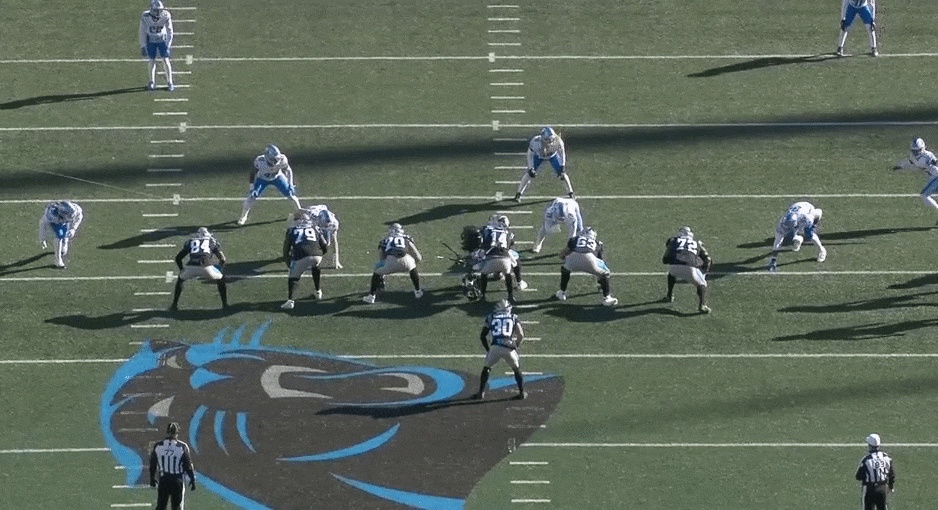
With the flow of the game what it was, Houston played just five snaps in the second half. Notably, one was a zone-read run to his side, where he stopped running back Chuba Hubbard after a 2-yard gain. Maybe it’s a leap in logic, but showing that skill possibly factored into the team feeling OK with testing Houston in a three-down role for the first time the following week.
▶ vs. Chicago Bears, Jan. 1, 33 snaps
It was noticeable when the Lions defense took the field to open last Sunday’s game that Houston was part of the starting unit. In the previous five games, he tallied a total of seven first-quarter snaps. In a full-time role for the first time, he finished the first frame of this one having been on the field for 10 plays.
And, maybe as we should have expected, it wasn’t smooth sailing from the jump. On the game’s third snap, he committed the cardinal sin of over-running the pocket against Justin Fields, proving the dual-threat quarterback with a clear escape lane.
And on Fields’ 35-yard run on a toss from tight end Cole Kmet, Houston got pinned inside the lane by receiver N’Keal Harry, which is never a great look for an edge defender.
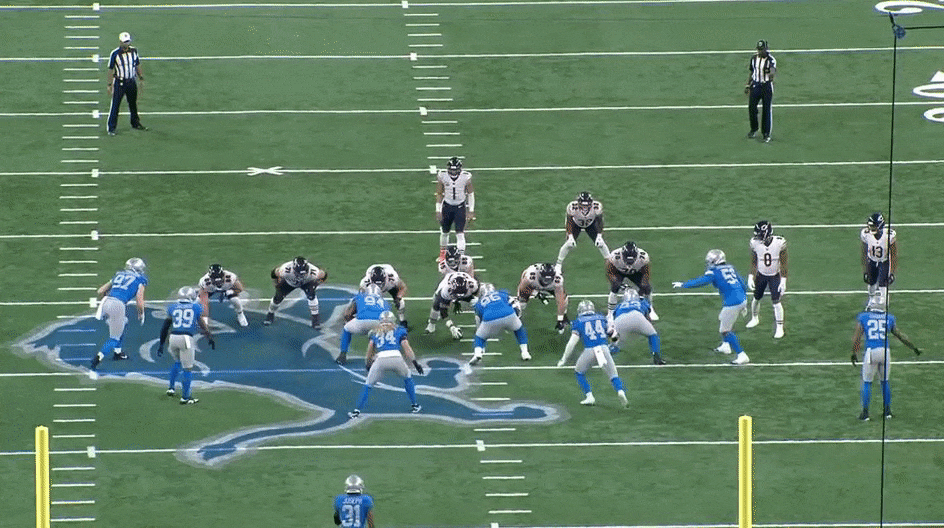
And Houston also got chopped down cleanly by the back on Chicago’s opening-drive touchdown. That’s three uncharacteristic plays, but in situations he hadn’t been playing prior to this game.
The discipline started to settle down in the second quarter. For example, Houston did a nice job staying with the quarterback on a backside rollout after a handoff, putting himself in good position had Fields kept the ball. Ultimately, that led to Houston’s first of three sacks, when he barreled left tackle Braxton Jones direction into the quarterback.
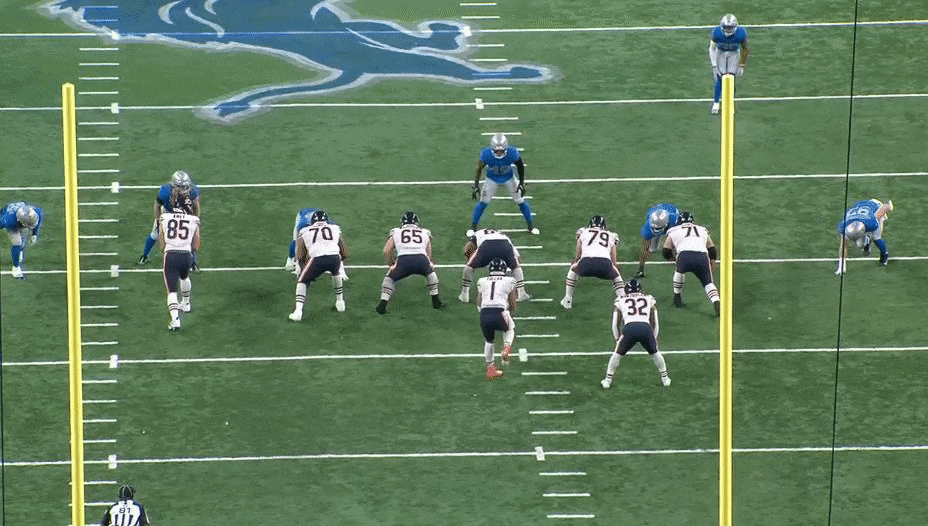
And on the ensuing series, Houston had one of the game’s biggest plays. After staying in front of Fields and redirecting the quarterback with better rush discipline, Houston was able to reverse direction and chase the QB down from behind.
Showing excellent situational awareness, Houston saw the ball was unsecure and chopped it free from Fields’ grasp, resulting in turnover.
Houston’s third sack sack came late in the third quarter, and it’s a little difficult to describe because the coverage scheme is unclear. Our best guess is the Lions’ were in Cover-1, with Houston supplementing the coverage by dropping into a shallow zone on the snap.
What’s also unclear is if he had spy responsibilities on Fields, but when the quarterback bailed from the pocket, Houston didn’t hesitate to attack, showing impressive closing burst and wrapping Fields up for a 9-yard loss.

Three sacks and a forced fumble makes Houston a strong contender for the NFC Defensive Player of the Week. More importantly, he showed his impact doesn’t go down with more reps.
More: Lions rookie linemen have monster day in win over Bears
Lingering concerns — if you can call them that in light of this massive amount of production he’s put forth — are his rush discipline against mobile quarterbacks and his able to set a hard edge against the run.
Houston is so bendy that he needs to constantly remind himself not to overrun the pocket against dual-threats. As for defending the run, the Bears didn’t often try to pound the ball Houston’s direction, but you could regularly see him getting overwhelmed by an offensive tackle when trying to anchor on the backside of the play.
Those are areas meriting continued development as he grows into a potential three-down player. Otherwise, the Lions have clearly found themselves an absolute steal, who, if nothing else, has enough rush versatility to sustain his early-career success disrupting the pocket.
jdrogers@detroitnews.com
Twitter: @Justin_Rogers